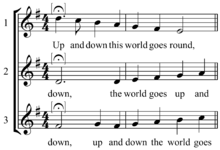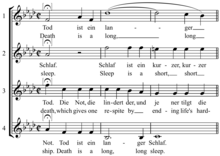
Accordions are a family of box-shaped musical instruments of the bellows-driven free reed aerophone type. The essential characteristic of the accordion is to combine in one instrument a melody section, also called the diskant, usually on the right-hand keyboard, with an accompaniment or Basso continuo functionality on the left-hand. The musician normally plays the melody on buttons or keys on the right-hand side, and the accompaniment on bass or pre-set chord buttons on the left-hand side. A person who plays the accordion is called an accordionist.

In music, counterpoint is a method of composition in which two or more musical lines are simultaneously played which are harmonically correlated yet independent in rhythm and melodic contour. It has been most commonly identified in the European classical tradition, strongly developing during the Renaissance and in much of the common practice period, especially in the Baroque period. The term originates from the Latin punctus contra punctum meaning "point against point", i.e. "note against note".
Articles related to music include:
In music, perpetuum mobile, moto perpetuo (Italian), mouvement perpétuel (French), movimento perpétuo (Portuguese) movimiento perpetuo (Spanish), carries two distinct meanings: first, as describing entire musical compositions or passages within them that are characterised by a continuous stream of notes, usually but not always at a rapid tempo; and also as describing entire compositions, or extended passages within them that are meant to be played in a repetitious fashion, often an indefinite number of times.
A chord is in close harmony if its notes are arranged within a narrow range, usually with no more than an octave between the top and bottom notes. In contrast, a chord is in open harmony if there is more than an octave between the top and bottom notes. The more general term spacing describes how far apart the notes in a chord are voiced. A triad in close harmony has compact spacing, while one in open harmony has wider spacing.

Pachelbel's Canon is an accompanied canon by the German Baroque composer Johann Pachelbel. The canon was originally scored for three violins and basso continuo and paired with a gigue, known as Canon and Gigue for 3 violins and basso continuo. Both movements are in the key of D major. Although a true canon at the unison in three parts, it also has elements of a chaconne. Neither the date nor the circumstances of its composition are known, and the oldest surviving manuscript copy of the piece dates from 1838 to 1842.

In music, unison is two or more musical parts that sound either the same pitch or pitches separated by intervals of one or more octaves, usually at the same time. Rhythmic unison is another term for homorhythm.
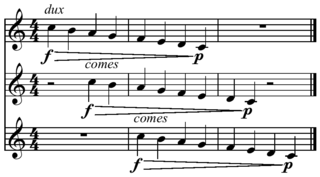
In music, a canon is a contrapuntal (counterpoint-based) compositional technique that employs a melody with one or more imitations of the melody played after a given duration. The initial melody is called the leader, while the imitative melody, which is played in a different voice, is called the follower. The follower must imitate the leader, either as an exact replication of its rhythms and intervals or some transformation thereof. Repeating canons in which all voices are musically identical are called rounds—familiar singalong versions of "Row, Row, Row Your Boat" and "Frère Jacques" that call for each successive group of voices to begin the same song a bar or two after the previous group began are popular examples.

"Three Blind Mice" is an English nursery rhyme and musical round. It has a Roud Folk Song Index number of 3753.
In Western music and music theory, augmentation is the lengthening of a note or the widening of an interval.

The Symphony No. 3, Op. 36, also known as the Symphony of Sorrowful Songs, is a symphony in three movements composed by Henryk Górecki in Katowice, Poland, between October and December 1976. The work is indicative of the transition between Górecki's earlier dissonant style and his later more tonal style and "represented a stylistic breakthrough: austerely plaintive, emotionally direct and steeped in medieval modes". It was premièred on 4 April 1977, at the Royan International Festival, with Stefania Woytowicz as soprano and Ernest Bour as conductor.

Liederkreis, Op. 39, is a song cycle composed by Robert Schumann. Its poetry is taken from Joseph von Eichendorff's collection entitled Intermezzo. Schumann wrote two cycles of this name – the other being his Opus 24, to texts by Heinrich Heine – so this work is also known as the Eichendorff Liederkreis. Schumann wrote, "The voice alone cannot reproduce everything or produce every effect; together with the expression of the whole the finer details of the poem should also be emphasized; and all is well so long as the vocal line is not sacrificed." Liederkreis, Op. 39, is regarded as one of the great song cycles of the 19th century, capturing, in essence, the Romantic experience of landscape. Schumann wrote it starting in May 1840, the year in which he wrote such a large number of lieder that it is known as his "year of song" or Liederjahr.
In music rondellus is the formalized interchange of parts or voices according to a scheme, often used in English conducti and frequently in English motets of the late thirteenth and early fourteenth centuries, but never used for an entire piece. For example:
A B C D E F C A B F D E B C A E F D
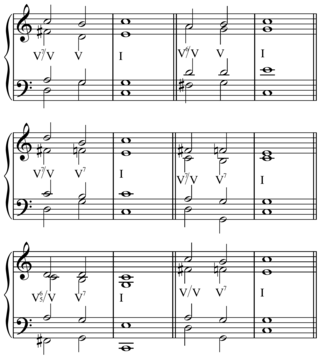
In music theory, voicing refers to two closely related concepts:
- How a musician or group distributes, or spaces, notes and chords on one or more instruments
- The simultaneous vertical placement of notes in relation to each other; this relates to the concepts of spacing and doubling
In music, a catch is a type of round or canon at the unison. That is, it is a musical composition in which two or more voices repeatedly sing the same melody, beginning at different times. Generally catches have a secular theme, though many collections included devotional rounds and canons.
In music theory, an inversion is a rearrangement of the top-to-bottom elements in an interval, a chord, a melody, or a group of contrapuntal lines of music. In each of these cases, "inversion" has a distinct but related meaning. The concept of inversion also plays an important role in musical set theory.
Eye music describes graphical features of scores which when performed are unnoticeable by the listener.
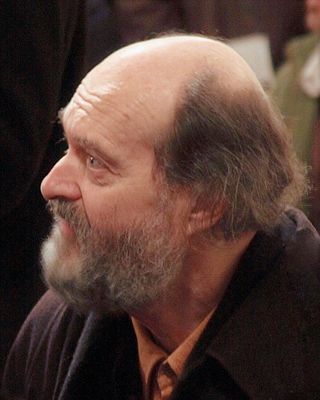
Symphony No. 4 Los Angeles is the fourth symphony by Estonian composer Arvo Pärt. It is the first of his symphonies to be written post-1976 and is in his signature tintinnabuli style. It is the first of his pieces that focuses on larger scale, instrumental tintinnabulation. Previous pieces, such as Summa and Für Alina, were typically written for SATB choir or a smaller number of instruments. Composed in 2008, and premiered 10 January 2009, Symphony No. 4 was nominated for a 2010 Grammy Award for Best Classical Contemporary Composition, although he did not receive the award.
"Danket, danket dem Herrn" is a Christian hymn in German. The short text is taken from psalms. The music is traditional, from the 18th century. It is a round, often used for grace after meals, but also used for other occasions of thanksgiving. The song is included in German Protestant and Catholic hymnals and many songbooks, and is considered to be among the most widespread rounds in German.
